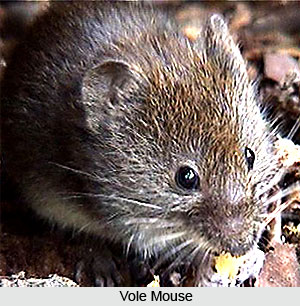 Voles are small rodents which are somewhat similar to a mouse. These are small rather secretive rodents belonging to the family Cricetidae. They are characterized by rather short tails and rounded blunt muzzles. Most of the voles live in the northern hemisphere and are palearctic in distribution. In India there are several species adapted to the temperate conditions of the Himalayan ranges. In the north-western parts are two very large voles of strongly burrowing habits: True`s Vole (Hyperacrius fertilis) and the Murree Vole (H.wynnei), both of which extend from Pakistan into Kashmir. The former occurs in alpine meadows above the tree-line whilst the latter is associated with mixed coniferous and deciduous forest in the lower or outer hill ranges and has become quite a serious pest of apple orchards, gnawing the bark at the base of the tree trunk.
Voles are small rodents which are somewhat similar to a mouse. These are small rather secretive rodents belonging to the family Cricetidae. They are characterized by rather short tails and rounded blunt muzzles. Most of the voles live in the northern hemisphere and are palearctic in distribution. In India there are several species adapted to the temperate conditions of the Himalayan ranges. In the north-western parts are two very large voles of strongly burrowing habits: True`s Vole (Hyperacrius fertilis) and the Murree Vole (H.wynnei), both of which extend from Pakistan into Kashmir. The former occurs in alpine meadows above the tree-line whilst the latter is associated with mixed coniferous and deciduous forest in the lower or outer hill ranges and has become quite a serious pest of apple orchards, gnawing the bark at the base of the tree trunk.
They feed on seeds, conifer needles, tubers, bark and a number of green vegetation like clover and grass as well as insects. There are also some species of Voles which even die if unable to get their main meal - Douglas fir needles - for a longer period. Voles form the food of several predators like raccoons, owls, martens, hawks, foxes, snakes, coyotes and the red tailed hawk, cats and weasels. The most common enemies of Voles are the short-eared owl, the Saw-whet Owl, the northern spotted owl, the Northern Pygmy Owl and the barn Owl.
In the inner hills at higher altitudes there are two more high-altitude voles with longer tails and less fossorial habits. Royle`s Vole (Alticola roylei) and the Sikkim Vole (Pitymys sikimensis). The former occurs in the western part of the Himalayas from Pakistan to Kimaon, whilst the latter occurs in Sikkim. Baluchistan forms the easternmost range of the Mole Vole (Ellobius fuscocapillus) which is the most adapted of all to a fossorial life, having almost lost the power of vision and with tiny ears hidden in its short velvety body fur.
This article is a stub. You can enrich by adding more information to it. Send your Write Up to content@indianetzone.com











